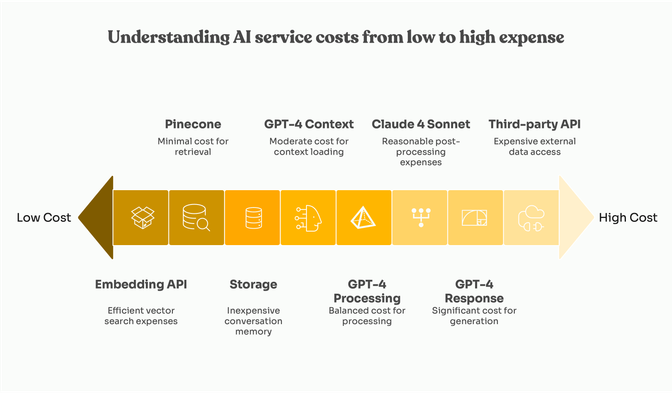Understand exactly what each agent costs to operate
See agent costs in real-time, not after your infra bill arrives.



You built an AI product. Your customers love it. Usage is exploding.
Then your AWS bill arrives.
That customer paying $500/month? They just burned $6,000 in compute. Your "successful" AI feature is now your fastest path to bankruptcy.
This isn't hypothetical. It's happening right now to AI companies that can't answer one simple question: What does each agent interaction actually cost?
Traditional SaaS taught us that more usage equals more value. Add another user, marginal cost approaches zero. Beautiful unit economics.
AI flipped this completely.
Every agent interaction costs real money. Every prompt burns compute. Every workflow triggers cascading API calls. And unlike SaaS, these costs compound exponentially with usage.
The Math That's Killing AI Companies:
Business Model | Monthly Revenue | Monthly Costs | Gross Margin | Unit Economics |
|---|---|---|---|---|
Traditional SaaS | $1,000 | $50 | 95% | Profitable at scale |
AI Company (Light Usage) | $1,000 | $400 | 60% | Sustainable |
AI Company (Average Usage) | $1,000 | $1,200 | -20% | Losing money |
AI Company (Heavy Usage) | $1,000 | $3,000 | -200% | Bankruptcy path |
You're literally paying customers to use your product.
It’s true that even most AI companies track revenue religiously but have zero visibility into agent-level costs. They know what customers pay but they have no idea what customers cost.
This creates three deadly problems:
1. You can't identify which agents hemorrhage money
Some agents run simple workflows. Others orchestrate complex multi-model chains. Without granular cost tracking, they all look the same on your dashboard.
2. You can't price anything correctly
How do you price a feature when you don't know if it costs $0.01 or $10 per use? Most teams guess. Then they scale. Then they discover they guessed wrong.
3. You can't optimize what you can't measure
That agent making 50 API calls? Maybe it only needs 5. But without visibility, you'll never know you're burning money on redundant operations.
While most AI companies struggle with razor-thin margins, outliers like Midjourney demonstrate what's possible when you achieve surgical precision in cost management: $18 million in revenue per employee.
This isn't luck. This is the result of understanding exactly what each AI operation costs and optimizing relentlessly around those economics. Midjourney's extraordinary efficiency comes from treating every inference, every compute cycle, every API call as a measurable economic event.

The companies achieving these extraordinary efficiency levels share one critical capability: real-time visibility into their cost structure at granular levels.
Here's what makes AI economics uniquely dangerous:
Variable Costs at Every Layer:
Cost Component | Range per Unit | Pricing Unit | Predictability |
|---|---|---|---|
LLM Inference | $0.015-$0.060 | Per 1M tokens | Medium |
Vector DB Queries | $0.001-$0.010 | Per search | High |
External APIs | $0.01-$1.00 | Per call | Low |
GPU Compute | $0.10-$5.00 | Per hour | Medium |
Memory/Storage | $0.05-$0.20 | Per GB/month | High |
Embeddings | $0.0001-$0.002 | Per 1K tokens | High |
Fine-tuned Models | $0.120-$0.360 | Per 1M tokens | Medium |
The Multiplication Effect:
One customer conversation might trigger:
Workflow Step | Service Used | Cost per Call | Calls per Conversation | Total Cost |
|---|---|---|---|---|
Context Loading | GPT-4 | $0.03 | 1 | $0.03 |
RAG Retrieval | Pinecone | $0.00 | 5 | $0.01 |
External Data | Third-party API | $0.05 | 2 | $0.10 |
Processing | GPT-4 | $0.06 | 1 | $0.06 |
Vector Search | Embedding API | $0.00 | 10 | $0.01 |
Response Generation | GPT-4 | $0.12 | 1 | $0.12 |
Post-processing | Claude 3 | $0.08 | 1 | $0.08 |
Conversation Memory | Storage | $0.02 | 1 | $0.02 |
Total | - | - | 22 | $0.43 |
Suddenly that "simple" chat costs $0.43. Customer has 1,000 chats daily? That's $430/day in direct costs. On a $50/month plan.
Forget ARR. Forget growth rate.
If you can't calculate your Agentic Margin Ratio (AMR), you're running blind.
The AMR is defined as the profit of your agent divided by it's total revenue, or AMR = (Agent Revenue - Agent Costs) / Agent Revenue
In order to calculate your AMR, you need to know:
Most companies can't answer any of these. They're optimizing for growth while their economics implode underneath.

The AMR benchmark example from one Paid's customers:
Workflow Step | Service Used | Cost per Call | Calls per Conversation | Total Cost |
|---|---|---|---|---|
Context Loading | GPT-4 | $0.03 | 1 | $0.03 |
RAG Retrieval | Pinecone | $0.00 | 5 | $0.01 |
External Data | Third-party API | $0.05 | 2 | $0.10 |
Processing | GPT-4 | $0.06 | 1 | $0.06 |
Vector Search | Embedding API | $0.00 | 10 | $0.01 |
Response Generation | GPT-4 | $0.12 | 1 | $0.12 |
Post-processing | Claude 3 | $0.08 | 1 | $0.08 |
Conversation Memory | Storage | $0.02 | 1 | $0.02 |
Total | - | - | 22 | $0.43 |
Companies that survive the AI transition share one capability: they know what every agent interaction costs in real-time.
This is, like with other measures, a spectrum. You likely have something through some of your providers (e.g., a monthly aggregate from OpenAI's dashboard) - but you don't have real-time per-customer.
That's fine - but you need to understand where you are and where you need to get to.
Maturity Level | Tracking Capability | Optimization Speed | Typical Margins | Survival Rate |
|---|---|---|---|---|
Level 0 | No tracking | Never | -50% to -200% | < 10% |
Level 1 | Monthly aggregates | Quarterly | -20% to 0% | 25% |
Level 2 | Daily reports | Monthly | 0% to 20% | 50% |
Level 3 | Hourly dashboards | Weekly | 20% to 40% | 75% |
Level 4 | Real-time per interaction | Daily | 40% to 60% | 90% |
Level 5 | Predictive + real-time | Continuous | 60%+ | 95% |
This means:
Without this, you're not running a business. You're running a charity for your cloud providers.
While your competitors fly blind into margin destruction, Paid provides the surgical precision in cost tracking that separates survivors from casualties in the AI economy.
Your AI agents are spending money every second they run.
Paid's agentic monetization stack tracks it all:
We know you can't optimize what you can't measure, so we also provide
While your competitors scale blindly into bankruptcy, you can scale with the confidence that comes from knowing exactly what every agent costs and exactly what every customer pays.
See agent costs in real-time, not after your infra bill arrives.




Price smarter. Protect margins. Grow revenue.